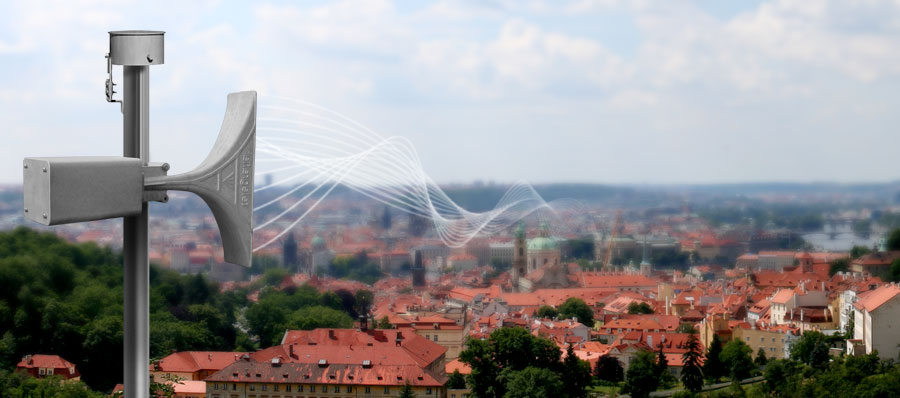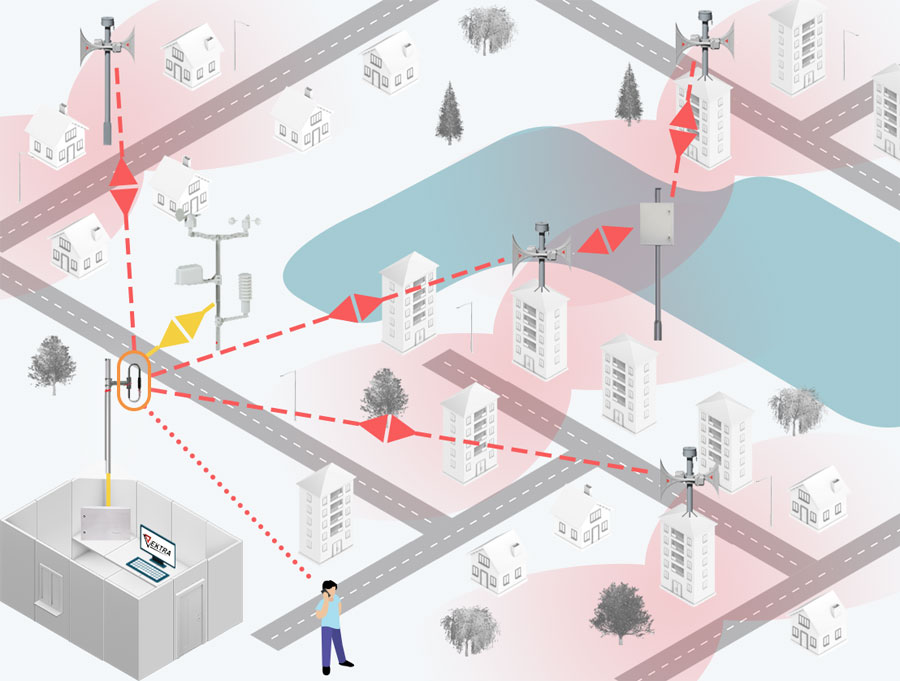City early warning systems, like national early warning systems, are built to warn against the so-called common danger, such as flood, fire, or other natural disasters. The relationship between the city and national early warning systems is governed by the legislation of a particular country. In some countries, there is only a national early warning system, in others, only city early warning systems.
City
warning systems
City
warning systems

Why to build city warning systems
City early warning systems, like national early warning systems, are built to warn against the so-called common danger, such as flood, fire, or other natural disasters. The relationship between the city and national early warning systems is governed by the legislation of a particular country. In some countries, there is only a national early warning system, in others, only city early warning systems.

City warning system description
The solution of a city early warning system offered by Telegrafia is designed in the manner that the city council members are able to notify the population of and warn them against imminent dangers immediately, only in the course of a few seconds. Most frequently, the population is first informed of the type of danger and further instructions are then provided to take action, for example, to turn on one of the electronic means of mass media communication.
The warning system is controlled from the main control centre equipped with the Vektra® software application, which, apart from controlling and monitoring sirens and communication channels, additionally supports the ongoing processes in this centre after the declaration of a state of emergency. This mainly includes automated notification and summons of the first responders (rescue teams, emergency management units, fire and health organizations, etc.) so that they can report for duty in answer to a summons and inform the relevant institutions in accordance with emergency plans. Within a few seconds, the system is able to activate any siren or group of sirens (depending on access rights) and, within a few minutes, it provides the feedback information on the successful system activation. In larger cities, sirens within the system can be controlled from district control centres. The entire system is fully backed up by batteries and fully operational even after power failure. It is possible to control all sirens simultaneously, groups of sirens located in city districts, but also each siren separately.
The main control centre allows users to control:
- Sirens installed in the city early warning system.
- Private-owned sirens installed in autonomous early warning systems operated by potentially hazardous industrial companies.
- Interior PA systems installed in buildings (for example, large shopping centres) or exterior PA systems installed in public areas (for example, sport facilities
Two communication lines are used to communicate between the individual elements within the system:
- A primary two-way communication line through the radio infrastructure at a designated frequency band, which means broadcasting instructions to sirens and receiving information from sirens about their statuses.
- A secondary back-up communication line (for example, through POCSAG, GPRS, or satellite systems).
A city early warning system consists of:
- The main, superior city early warning and notification centre.
- District, inferior early warning and notification centres (in larger cities).
- Radio communication infrastructure (or radio modems in the event of smaller towns).
- A network of several dozens to hundreds of the Pavian sirens.
- Interfaces for autonomous early warning and PA systems.

City warning system description
The solution of a city early warning system offered by Telegrafia is designed in the manner that the city council members are able to notify the population of and warn them against imminent dangers immediately, only in the course of a few seconds. Most frequently, the population is first informed of the type of danger and further instructions are then provided to take action, for example, to turn on one of the electronic means of mass media communication.
The warning system is controlled from the main control centre equipped with the Vektra® software application, which, apart from controlling and monitoring sirens and communication channels, additionally supports the ongoing processes in this centre after the declaration of a state of emergency. This mainly includes automated notification and summons of the first responders (rescue teams, emergency management units, fire and health organizations, etc.) so that they can report for duty in answer to a summons and inform the relevant institutions in accordance with emergency plans. Within a few seconds, the system is able to activate any siren or group of sirens (depending on access rights) and, within a few minutes, it provides the feedback information on the successful system activation. In larger cities, sirens within the system can be controlled from district control centres. The entire system is fully backed up by batteries and fully operational even after power failure. It is possible to control all sirens simultaneously, groups of sirens located in city districts, but also each siren separately.
The main control centre allows users to control:
- Sirens installed in the city early warning system.
- Private-owned sirens installed in autonomous early warning systems operated by potentially hazardous industrial companies.
- Interior PA systems installed in buildings (for example, large shopping centres) or exterior PA systems installed in public areas (for example, sport facilities
Two communication lines are used to communicate between the individual elements within the system:
- A primary two-way communication line through the radio infrastructure at a designated frequency band, which means broadcasting instructions to sirens and receiving information from sirens about their statuses.
- A secondary back-up communication line (for example, through POCSAG, GPRS, or satellite systems).
A city early warning system consists of:
- The main, superior city early warning and notification centre.
- District, inferior early warning and notification centres (in larger cities).
- Radio communication infrastructure (or radio modems in the event of smaller towns).
- A network of several dozens to hundreds of the Pavian sirens.
- Interfaces for autonomous early warning and PA systems.

Elements of a city warning system
The main city early warning and notification centre
The main national early warning and emergency notification centre is the superior computerised control centre equipped with the Vektra® software, the central communication unit to control sirens by radio, and with other hardware to provide back-up, notification and further communication within the system. The entire system is fully backed up by batteries and fully operational even after power failure. The centre allows control of all city sirens, including those that are part of private autonomous early warning systems and PA systems. The Vektra® software permanently monitors the status of the entire technology (of both the sirens and communication infrastructure). Upon the declaration of a state of emergency, it provides support to the processes ongoing in the centre, mainly notification of the responsible persons and institutions and recording telephone and radio communication messages for the purpose of further analysis. The software also uses all functions of the Pavian sirens, particularly their autodiagnostic functions, which allow the monitoring of all important parameters and performing of the so-called “quiet” tests that completely verify the functionality of these sirens.
District early warning and notification centres
An individual district early warning and notification centre can be also equipped with the Vektra® software that serves the same functions as the main city early warning and notification centre, or only with the LCU15 local control module that allows the activation of sirens in a specific city district depending on its area and other relevant factors.
Radio communication infrastructure
As a rule, a designated radio channel is used as the main communication channel; however, a satellite control channel or standard WiFi communication network can be used to control sirens as well. Radio modems installed in sirens, which typically form their optional parts/modules, are sufficient for communication needs at designated radio frequencies. These modules also offer the possibility of each siren being used as a retransmitting station, thereby remarkably lower the costs of building the radio communication infrastructure. In the case of bigger cities, more developed areas or rugged terrains, independent retransmitting stations or the SMART communication units can be used. The use of WiFi technology requires the establishment of independent communication infrastructure that takes into consideration the limited coverage area of individual transmitters. The use of satellite communication is simple as it means the installation of a specific satellite data modem in each siren delivered by the relevant service provider; nevertheless, the operational costs are still relatively high. A back-up control channel can be selected according to the local conditions and type of the main communication channel, and it should not share any elements of the main communication infrastructure.
Pavian Electronic sirens
The Pavian electronic sirens are used as terminal acoustic elements. They are designed to cover a given populated area by the acoustic signal of a desired acoustic pressure. In most countries, both the populated area and the value of the desired acoustic pressure (depending on the background noise of the relevant area) are stipulated directly by legislation. Since this early warning and emergency notification system must meet extremely stringent requirements, all the advanced functions of the Pavian siren series are fully used, particularly its autodiagnostic functions.
Interfaces for autonomous warning and PA systems
The law in most countries directly obliges companies to build fire alarm and emergency evacuation systems in their buildings. In some countries, there is also a legal obligation to interconnect these systems and city early warning systems, mainly in order to carry warning signals into the exterior. With respect to the way of life in cities and sound insulation properties of new buildings, it is possible to substantially increase the effect of warning by this interconnection. Moreover, this effect can be further increase by the connection of such systems with autonomous warning systems of potentially hazardous industrial companies.